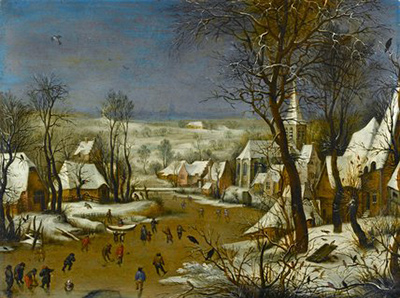Pieter Bruegel the Elder laid the foundations to a family dynasty which lasted several generations and dominated Dutch and Flemish Renaissance painting. His own work is best remembered for its landscapes and lively depictions of the poor, earning him the nickname, Peasant Bruegel.
Whilst the artist demonstrated a strong connection to the poorer elements of society, which was highly unusual for artists at the time, he was actually from a relatively wealthy background. Initially, art historians concluded that he must have come from humble beginnings in order to relate to the subjects in his work just as much as he did, but more recently other aspects of his work have pointed to a more rounded education.
Bruegel's biggest legacy was in his promotion of landscape art and also in his role as printmaker, which helped to bring art to the masses. He turned away from the norms of the day, which tended to cover religious and portrait themes, and instead captured the lives of the working poor in a charming and positive manner. All these centuries later, his work still continues to amuse and excite a global art audience.
Early Life
Pieter Bruegel the Elder was born at some point between the years of 1525–1530. His birthplace is believed to have been either Breda or Brueghel in modern-day Netherlands. The latter is described as a small village which cannot be connected to any existing location today, whilst Breda remains a flourishing city in the south of the country.
Estimates around his date of birth are based on our knowledge of him entering Antwerp painters' guild in 1551. He trained under the guidance of Pieter Coecke van Aelst whilst working here, but had already served under Pieter Coecke (1545-1550) and Peeter Baltens (1550-1551) by this point. Interestingly, several of these individuals had fellow artists within their families, which perhaps gave Pieter the inspiration for encouraging his own offspring into the industry.
Travels Abroad
The artist travelled across Europe in the 1550s, hoping to expand his technical knowledge and evolve as an artist. In the earliest part of this decade he can be traced to the Guild of Saint Luke of Antwerp, before heading off abroad to Italy and France. He worked collaboratively with a number of local artists whilst on this journey of discovery and perhaps found this the best way in which to take on new techniques from these different regions.
By 1555, and having spent considerable time in the likes of Rome and Sicily, the artist settled back in Northern Europe. He worked professionally in Antwerp, sketching designs which experienced printmakers would then translate into plates. His extended period in Antwerp allowed the artist to build relationships with a number of patrons and the city boasted a wealth of opportunities for artists at that time. He surrounded himself with intellectuals and some of this influence would make its way into his work.
Family Life
The artist married Mayken Coecke in 1563, with the family moving to Brussels. Some have suggested that Bruegel had a mistress at the time in Antwerp, and that the move away was designed to help strengthen the new marriage. Brussels offered different opportunities to that of Antwerp and eventually Bruegel decided to focus entirely on painting. He acquired a number of notable patrons who ensured a steady income for his work. The couple soon had children together, and Pieter would train his sons to become accomplished painters in their own right.
Jan and Pieter the Younger arrived just before the artist's death, and so were not able to learn directly from their father, but instead were able to refer directly to his detailed paintings and over time managed to understand most of the techniques used by their famous father. They would also have been supported by some of Pieter the Elder's artistic and political connections, with this region continuing to boast a rich artistic culture for several generations to come.
Pieter Bruegel the Elder died on the 9th of September, 1569. Depending on when he was born, which remains unconfirmed, he would have been in his late thirties or early forties at the time of his death. He was buried at the Church of Our Lady of the Chapel in Brussels, where a monument was erected in his honour.
Technique and Style
The trademark of Bruegel's style is in his use of sprawling scenes, littered with all manner of figures. It continued the work of Bosch, another significant artist from Northern Europe, but swapped fantasy for real life peasantry. Viewers of his most famous works would be amazed by the detail displayed across each canvas, with activity crammed into each and every corner of the composition. There was a level of charm and fun to Bruegel's paintings that went unmatched across the Renaissance.
Bruegel was unique in moving away from a single point of focus, but rather spreading interest out across each piece. Different incidents and events will be displayed separately across these larger artworks, contrasting with the more typical approach in which the viewer's eye is purposely directed precisely at one section. His coverage of everyday life was to become known as genre painting and was seen more frequently in Northern European during the Dutch Golden Age.
Legacy
Peasant Bruegel, as he became known by some, helped to expand the scope of North European art, capturing the lives of the working poor and also depicting them in a more positive light than had normally been the case up to that point. Bruegel was also one of a number of socially-conscious artists who would turn to printmaking as a means to spread their message to all levels of society, with copies of their work being available at relatively nominal prices.




